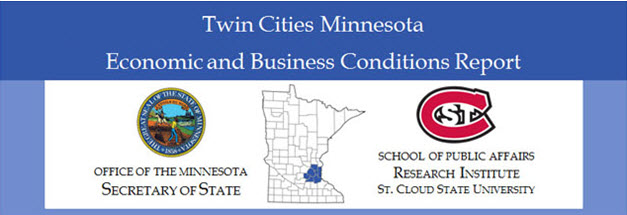Publication Title
Twin Cities Minnesota Economic and Business Conditions Reports
Document Type
Research Study
Publication Date
6-13-2019
Financial Year
2018
Abstract
A slowing of economic growth is expected in the Twin Cities planning area according to the predictions of the Twin Cities Index of Leading Economic Indicators (LEI). The Twin Cities LEI decreased 7.97 points in the fourth quarter of 2018 as all five index components registered negative values. A decrease in the Minnesota Business Conditions Index (a general measure of statewide business conditions), higher initial jobless claims in the region, and a decline in the Federal Reserve Bank of Philadelphia Minnesota Leading Economic Indicators Index series helped drive the Twin Cities LEI lower. Fewer residential building permits in the Twin Cities metropolitan area and a reduction in the number of new filings of incorporation and LLC in the region also unfavorably impacted the Twin Cities outlook.
There were 10,321 new business filings with the Office of the Minnesota Secretary of State in the seven-county metro area in the fourth quarter of 2018—representing a 1.4 percent decrease from one year ago. 1,361 new regional business incorporations were tallied in the Twin Cities in the fourth quarter—4.6 percent fewer than year ago levels. Fourth quarter new LLC filings rose to 6,741 in the seven-county metro area—a 0.7 percent increase compared to the fourth quarter of 2017. New assumed names were 7.7 percent lower in the fourth quarter and there were 22 more new non-profit filings in the Twin Cities than one year ago.
Fifty-nine percent of new business filers in the Twin Cities planning area completed the voluntary Minnesota Business Snapshot (MBS) survey in the fourth quarter. Results of this voluntary survey indicate that 16.6 percent of new filers come from communities of color. 4.8 percent of new filings are veterans. 2 percent of new filers come from the disability community and 10.8 percent of new filings are made by the immigrant community. Approximately thirty-seven percent of new business filings in the Twin Cities planning area in the fourth quarter were initiated by women. MBS results also show that most new business filers in the Twin Cities have between 0 and $10,000 in annual gross revenues (although 579 new filers have revenues in excess of $50,000). The most popular industries for new businesses in the Twin Cities are professional/scientific/technical, retail trade, real estate/rental/leasing, construction, and other services. Employment levels at most new firms are between 0 and 5 workers, and 44.5 percent of those starting a new business consider this a part-time activity.
Twin Cities planning area employment increased by 1.1 percent over the year ending December 2018. At 2.6 percent, the planning area’s unemployment rate was slightly lower than one year earlier. Initial claims for unemployment insurance were 3.4 percent lower than year ago levels and average weekly wages rose by 4.2 percent over the most recent year. The planning area’s labor force rose by 0.9 percent over the year ending December 2018. Average hourly earnings and average weekly work hours rose for private sector workers in the 16-county Minneapolis-St. Paul MSA over the year ending December 2018 and the relative cost of living rose in both Minneapolis and St. Paul. There was a 16.9 percent decline in the value of new residential building permits in the Minneapolis-St. Paul MSA over the year ending December 2018. The number of annual bankruptcies fell by 2.2 percent in the Twin Cities.
Recommended Citation
Banaian, King and MacDonald, Richard, "Twin Cities Area Economic and Business Conditions Report Fourth Quarter 2018" (2019). Twin Cities Minnesota Economic and Business Conditions Report. 19.
https://repository.stcloudstate.edu/qebcr_tc_mn/19




